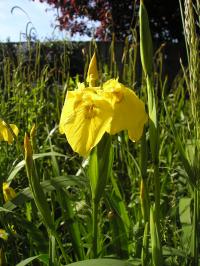Beat the Bindweed!

A technique for controlling bindweed, pruning spring flowering shrubs and a profile of Iris pseudoacorus.
I think most of you would agree that the last plants in the garden to show the symptoms of drought are the weeds. This week I have been dealing with one weed that certainly does not seem to be affected by dry conditions at all and can be a real problem in the garden if it is given the opportunity. I have a couple of shrubs with Field Bindweed growing up through them. This vigorous broad-leaved weed is the python of the "weeds". It twines it's way up a host, using it as a climbing frame. It constricts and chokes the host plant and reduces light absorption with its broad leaves. It also competes for moisture at root level.
When you discover Field Bindweed in your garden it is very tempting to just dig it out, but the thick fleshy, distinctive white roots are also very brittle and it is very easy to leave pieces behind in the soil with the digging process. I prefer to drive bamboo canes into the soil amongst the host plant and then train the bindweed up the canes. I then, very carefully, paint the shoots of the bindweed with a glyphosate-based herbicide. I do this very carefully with an old paintbrush, wearing rubber gloves and goggles (just incase it splashes in my eyes) and making every effort not to spill any on the host shrub. This type of herbicide is translocated, meaning that it will travel down the stem and into the root system, killing all parts of the bindweed. I have found this technique to be very successful and there is no root disturbance to the host shrub that digging would create.
Over the last fortnight I have spent quite a lot of time pruning spring flowering shrubs that have recently finished flowering. Shrubs like Forsythia, Spiraea and Kerria. It is best to do this pruning as soon as the flowering has finished because this gives the shrub a whole year to develop and ripen the wood that will flower at the same time next year. Taking Kerria as an example, (Jew's Mallow) I prune out the wood that has just flowered, down to fresh, young shoots that will produce next year's flowers. On older, sometimes previously neglected plants I prune out one-third of the stems right down to the base.
In the plantadvice wildlife garden the last couple of weeks has seen the yellow flag Iris coming in to bloom. When I was selecting plants for the wildlife garden Iris pseudoacorus (pictured) was one of the first plants on the list for the moist areas at the pond margins. This plant is native to the U.K. and throughout other parts of Europe where it can be found growing at the margins of ponds, lakes and other waterways. It has long, strap-like leaves that eventually form quite large clumps. If your wildlife garden is dominated by shades of green, the bright yellow flowers provide a welcome splash of an alternative bright colour. In the summer, it is very satisfying to see damselflies and dragonflies settling on the flowers of Iris pseudoacorus for a rest at the pond margins.
Other jobs I have been getting on with over the last couple of weeks:
- Tying in shoots of Clematis to their supports
- Feeding container-grown plants once per week
- Removing rootstock suckers from grafted roses
- Trimming hawthorn hedge in wildlife garden, having checked for nesting birds first
- Regular dead-heading
Filed under General.
